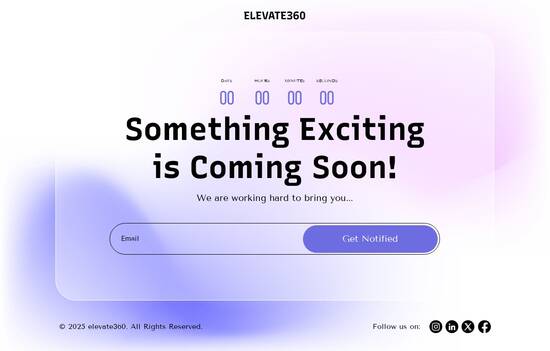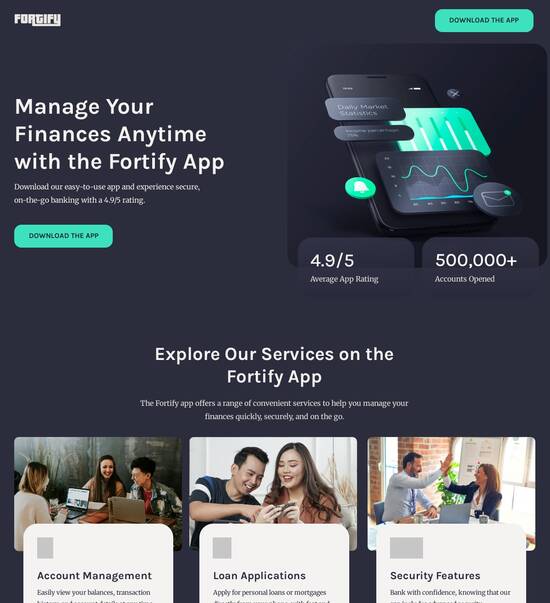
Company history page template compatible with Shopify
Explore Similar TemplatesAbout template
Build and integrate high-converting company history page templates with Shopify effortlessly!
Recommended templates

Easy to build without coding
With the intuitive drag-and-drop builder, anyone on your team can create high-converting pages without any knowledge of code or design. Make enhancements to your landing page with custom widgets using Javascript, HTML/CSS, or third-party scripts.

Multiple layouts for any industry and goal
Select from 500+ landing page layouts built to boost conversions across industry-specific scenarios. Customize them by adjusting fonts, adding images, and generating on-brand content with the AI assistant. Quickly scale with Instablocks® and Global Blocks that you can save, reuse, and update globally.

Loads fast and looks polished on any device
Every template is responsive, which means they present professionally on any device and load blazingly fast with our Thor Render Engine. You can also power them up with Google AMP technology to deliver an unparalleled mobile experience and drive higher conversions.

Robust analytics & experimentation
Get real-time updates and reporting across all your devices, showing the number of visitors, conversions, cost-per-visitor, and cost-per-lead. Launch AI-powered experiments, run A/B tests, and use heatmaps to analyze user behavior, then optimize your landing page to maximize conversions.







Easy to build without coding
With the intuitive drag-and-drop builder, anyone on your team can create high-converting pages without any knowledge of code or design. Make enhancements to your landing page with custom widgets using Javascript, HTML/CSS, or third-party scripts.
Multiple layouts for any industry and goal
Select from 500+ landing page layouts built to boost conversions across industry-specific scenarios. Customize them by adjusting fonts, adding images, and generating on-brand content with the AI assistant. Quickly scale with Instablocks® and Global Blocks that you can save, reuse, and update globally.
Loads fast and looks polished on any device
Every template is responsive, which means they present professionally on any device and load blazingly fast with our Thor Render Engine.
Robust analytics & experimentation
Get real-time updates and reporting across all your devices, showing the number of visitors, conversions, cost-per-visitor, and cost-per-lead. Launch AI-powered experiments, run A/B tests, and use heatmaps to analyze user behavior, then optimize your landing page to maximize conversions.
All the features you need to build lead-generating landing pages
Explore more featuresLearn how to build top-performing landing pages for any goal
FAQs
Leading the way in building high-performing landing pages





Accelerate your marketing campaigns with Instapage's landing page optimization strategies
In a digital-first landscape, marketers must leverage every tool at their disposal to maximize ROI and enhance conversion rates. Instapage stands as the most powerful platform, uniquely designed to help marketers construct landing pages that not only capture leads but also convey compelling narratives that resonate. With multiple functionalities, including optimization, personalization, and collaboration, Instapage simplifies the user experience for all team sizes and budgets.
Understanding the basics of landing page creation
Building effective landing pages is crucial for any campaign’s success. The use of intuitive builders allows marketers to effortlessly create pages without technical expertise. Here's how to get started:
- Choose from over 100 high-converting templates tailored for various industries to kickstart your project.
- Utilize Instablocks to save time; these reusable sections can be easily customized to fit your campaign's needs.
- Leverage lead generation elements like forms and interactive calls-to-action to enhance user engagement.
Implementing optimization strategies for higher conversions
To truly maximize your landing page's effectiveness, optimization is key. Instapage includes built-in A/B testing and heatmap functionalities to provide critical insights.
- Conduct A/B tests to evaluate different headlines and visuals that resonate most with your audience.
- Use heatmaps to analyze user behavior, understanding where visitors click and how they navigate your page.
- Examine conversion analytics to identify bottlenecks and enhance your page's performance.
Personalizing content to elevate audience engagement
Personalization is increasingly vital in creating high-performing marketing content. Tools for dynamic text replacement allow you to cater the experience to different audience segments.
- Utilize AdMaps for aligning specific ads with unique landing pages, ensuring cohesive messaging.
- Track metrics closely to fine-tune content for each audience group, adapting messaging based on their needs.
- Dynamically adjust offers or content based on previous interactions, increasing relevance and conversion likelihood.
By implementing these strategies, you can enhance both user experience and conversion rates.
In conclusion, Instapage equips marketers with the necessary tools to create and optimize landing pages that drive results effectively.
Ready to supercharge your digital marketing campaigns? Start a free trial with Instapage today and discover the power of optimized landing pages.
People also ask about Company history page template compatible with Shopify
Create a Compelling Company History Page Template for Shopify
Understanding the importance of a company history page in e-commerce
A company history page is a vital component of any e-commerce platform, particularly for Shopify stores. This page serves as a canvas for storytelling, a powerful tool that enables brands to engage customers meaningfully. Storytelling helps businesses communicate their vision, mission, and the values that define them, allowing consumers to connect at a deeper level. By sharing the brand's journey, including personal anecdotes and critical milestones, businesses can create a narrative that resonates with their audience.
Moreover, a well-crafted company history page strengthens brand identity. It provides context to the products or services offered while differentiating the brand in a crowded market. When customers understand the origins and evolution of a brand, they are more likely to feel aligned with its ethos. Additionally, such pages enhance consumer trust through authenticity and transparency. Customers are increasingly seeking brands that showcase their history and values, as this fosters a sense of reliability and connection.
Key features of a Shopify-compatible company history page template
When creating a company history page for your Shopify store, it is crucial to leverage a template that supports essential features to enhance user experience and brand representation. A well-designed template provides customizable layouts and design options, allowing brands to tailor the aesthetics to reflect their unique identity. For instance, templates may offer various color schemes and font choices, ensuring visual consistency that aligns with the overall branding.
Various template designs tailored for branding
Responsive layouts for seamless access on mobile and desktop
Visual consistency that aligns with the brand's aesthetic, enhancing user experience
User-friendly editing tools are another significant feature. Shopify-compatible templates often include drag-and-drop functionality, making it easy for users to modify content without needing technical expertise. Additionally, pre-built content sections facilitate effortless integration of historical milestones, timelines, and significant events into the page. This is particularly beneficial for non-technical users who wish to personalize their pages without grappling with coding or complex adjustments.
Finally, the integrated multimedia capabilities of these templates can elevate the storytelling experience. Incorporating images, videos, and graphics can engage visitors more effectively than text alone. Best practices suggest adding timelines to highlight critical milestones and integrating customer testimonials or success stories to illustrate the brand's impact. This combination not only informs but also emotionally engages the audience.
Crafting an engaging brand narrative
To create an engaging brand narrative on your company history page, it is essential to focus on key elements of a compelling story. Start with the origins of the business—what sparked the idea, and what inspired the founders? Detailing the journey, including pivotal moments and significant breakthroughs, can create a narrative arc that captures interest. Furthermore, integrating customer-centric stories that showcase positive impacts adds a layer of relatability, which is crucial for fostering an emotional connection with your audience.
Building an emotional connection entails using narrative techniques that resonate with visitors. This can include sharing challenges faced, lessons learned, and triumphs celebrated. Highlighting vulnerabilities showcases brand resilience and relativity, inviting consumers to root for the brand. By weaving together a rich tapestry of experiences, aspirational stories, and authenticity, brands can effectively forge lasting emotional bonds with their customers.
Optimizing company history pages for conversion
Optimizing your company history page for conversion is a crucial step in leveraging the traffic it garners. One effective strategy is embedding calls to action (CTAs) throughout the narrative. Strategically placed CTAs can guide customers through the conversion journey, directing them to explore products or make purchases. For instance, after detailing the brand’s mission and values, a CTA inviting viewers to shop the collection can harmoniously lead them into the sales funnel.
Strategically placed CTAs help guide customers through the conversion journey
Effective CTAs can relate to exploring products or making purchases, enhancing engagement
Utilizing social proof is another potent method for enhancing credibility. Customer reviews and testimonials can significantly boost a brand’s trustworthiness, especially when strategically placed on the history page. Additionally, showcasing partnerships, awards, or milestones attained can further enhance trust. Remember, potential customers often seek validation, and seeing that others have benefited can serve as a powerful motivator.
Designing for user experience is equally important. Ensure that the company history page loads quickly and is optimized for mobile use, as slow-loading pages can increase bounce rates. Organizing content effectively facilitates easy navigation and helps users find the information they seek without frustration. These elements collectively play a crucial role in the overall effectiveness of the page in converting visitors into customers.
Top mistakes to avoid when creating your company history page
As you design your company history page, be mindful of common pitfalls that can undermine its effectiveness. One significant mistake is failing to align your storytelling with your brand values and mission. If the narrative feels disjointed or inconsistent with other branding elements, it can confuse or alienate your audience. Ensure your history page reflects your ethos and reinforces your brand identity.
Another common error is overloading the page with information. Finding the right balance is critical; provide enough context to engage readers without overwhelming them with excessive detail. Aim for clarity and conciseness while still preserving a rich narrative. Lastly, neglecting SEO best practices can hinder visibility. Use relevant keywords naturally to enhance search engine performance, helping potential customers discover the rich story behind your brand.
Enhancing the company history page for e-commerce brands
Customizing the company history page template for various e-commerce niches is vital for relevance and impact. For instance, fashion brands might focus on style evolution and iconic moments, while technology brands could highlight innovation milestones or product launches. Lifestyle brands may benefit from sharing community engagement initiatives or personal stories linked to their offerings. Adapting the narrative to fit the specific audience ensures that the content resonates profoundly.
Moreover, utilizing data and analytics can further improve the effectiveness of the company history page. Shopify provides analytics tools to track user engagement, allowing brands to assess how visitors interact with the page. This data offers insights into popular sections, bounce rates, and overall performance, enabling informed content adjustments based on customer behavior insights. Regularly updating the page with fresh content or new milestones can keep the narrative relevant and engaging.
Frequently asked questions (FAQs)
When creating a company history page, many users ask what content is essential to include. A compelling history page should outline the origins of your brand, key milestones, the mission statement, and customer stories. Engaging narratives enable readers to develop a connection with your brand. Additionally, those new to e-commerce often inquire about the benefits of a company history page. It enhances brand trust, differentiates your business, and can improve overall customer relationships.
What should I include on my company history page?
How can a company history page benefit my Shopify store?
Can I integrate my company history page with other store features?
How often should I update my company history page?
Measuring success: tracking engagement on your company history page
To assess the effectiveness of your company history page, it’s essential to establish key performance indicators (KPIs). Metrics such as bounce rates, time spent on the page, and conversion rates provide insight into user engagement and the overall impact of the page on sales. By analyzing these KPIs, brands can identify areas for improvement and strategize accordingly.
Moreover, tools like Shopify analytics, in tandem with Google Analytics, can provide robust insights into page performance. These tools enable brands to track visitor behavior, providing detailed data on how users interact with the page. Analyzing this data helps in understanding what resonates with audiences, allowing for continual adjustments that improve engagement and conversion outcomes.
Emphasizing the value of authenticity and trust in brand storytelling
Authentic storytelling can significantly differentiate your brand in an overcrowded market. By presenting not just achievements, but also challenges and lessons learned, brands evoke trust and connect with their audience on a human level. Case studies of successful e-commerce brands illustrate how effectively implementing a company history page can enhance brand loyalty and customer relationships. Transparent communication about history fosters long-term connections, as customers appreciate brands that share their journey openly.
Investing time in crafting a compelling company history page can result in substantial payoffs. By focusing on authenticity and ensuring that the history page aligns with your brand values, you foster an environment of trust and loyalty. Ultimately, as your store grows, so too will the significant relationships you've built through storytelling.
Ready to skyrocket conversions?
Supercharge your ad campaigns with high-performing landing pages
Get started














